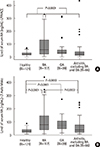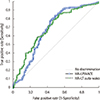Abstract
Background
Hyaluronic acid (HA) is present in the connective tissues wherein it functions as a lubricant. HA is known to be increased in both synovial fluid and serum when inflammation occurs in the joint. We measured serum HA concentrations by automated assays and determined its reference interval and its usefulness as a diagnostic marker in patients with rheumatoid arthritis (RA).
Methods
Serum specimens collected from 121 healthy individuals and 253 patients with various arthritis were used for measuring HA with two automated assays, namely, LPIAACE (Mitsubishi, Japan) and LT Auto Wako (Wako, Japan). The association between serum HA concentration and the diagnosis of RA was estimated by receiver operator characteristic (ROC) analysis and multivariate logistic regression.
Results
The 95th percentile upper reference limit of serum HA was 57.28 ng/mL (90% confidence interval [CI], 46.30-68.20 ng/mL) for LPIAACE and 72.64 ng/mL (90%% CI, 57.30-85.70 ng/mL) for LT Auto Wako. Area under the ROC curve values of serum HA for discriminating the RA group from the non-RA group were 0.68 for LPIAACE and 0.70 for LT Auto Wako. The odds ratio for serum HA in predicting RA was 1.02 (95% CI, 1.02-1.04) for LPIAACE and 1.03 (95% CI, 1.02-1.05) for LT Auto Wako.
Conclusions
This study provides a reference interval for serum HA concentrations in Koreans. This result suggests that the serum HA concentrations could be helpful as a complementary marker for discriminating RA from other types of arthritis, as well as distinguishing patients with RA from healthy controls.
Figures and Tables
 | Fig. 1Levels of serum HA among patients with RA, OA, arthritis excluding RA and OA, and healthy subjects. (A) LPIAACE; (B) LT Auto Wako. The upper and lower ends of boxes and box inner lines correspond to the 3rd and 1st quartiles and median values, respectively. Error bars denote minimum and maximum values, and circles indicate outlier values.
Abbreviations: HA, hyaluronic acids; RA, rheumatoid arthritis; OA, osteoarthritis.
|
 | Fig. 2ROC curves for serum concentration of HA in discriminating RA from unspecific arthritis. The AUCs are 0.68 (95% CI, 0.62-0.75; P<0.0001) and 0.70 (95% CI, 0.64-0.76; P<0.0001) for LPIAACE and LT Auto Wako, respectively. |
References
1. Pitsillides AA, Worrall JG, Wilkinson LS, Bayliss MT, Edwards JC. Hyaluronan concentration in non-inflamed and rheumatoid synovium. Br J Rheumatol. 1994; 33:5–10.

2. Nakayama Y, Shirai Y, Yoshihara K, Uesaka S. Evaluation of glycosaminoglycans levels in normal joint fluid of the knee. J Nippon Med Sch. 2000; 67:92–95.

3. Paimela L, Heiskanen A, Kurki P, Helve T, Leirisalo-Repo M. Serum hyaluronate level as a predictor of radiologic progression in early rheumatoid arthritis. Arthritis Rheum. 1991; 34:815–821.

4. Sharif M, George E, Shepstone L, Knudson W, Thonar EJ, Cushnaghan J, et al. Serum hyaluronic acid level as a predictor of disease progression in osteoarthritis of the knee. Arthritis Rheum. 1995; 38:760–767.

5. Laurent TC, Fraser JR, Laurent UB, Engström-Laurent A. Hyaluronan in inflammatory joint disease. Acta Orthop Scand Suppl. 1995; 266:116–120.

6. Fex E, Eberhardt K, Saxne T. Tissue-derived macromolecules and markers of inflammation in serum in early rheumatoid arthritis: relationship to development of joint destruction in hands and feet. Br J Rheumatol. 1997; 36:1161–1165.

7. Jain A, Nanchahal J, Troeberg L, Green P, Brennan F. Production of cytokines, vascular endothelial growth factor, matrix metalloproteinases, and tissue inhibitor of metalloproteinases 1 by tenosynovium demonstrates its potential for tendon destruction in rheumatoid arthritis. Arthritis Rheum. 2001; 44:1754–1760.

8. Wang JY, Roehrl MH. Glycosaminoglycans are a potential cause of rheumatoid arthritis. Proc Natl Acad Sci U S A. 2002; 99:14362–14367.

9. Poole AR, Witter J, Roberts N, Piccolo F, Brandt R, Paquin J, et al. Inflammation and cartilage metabolism in rheumatoid arthritis. Studies of the blood markers hyaluronic acid, orosomucoid, and keratan sulfate. Arthritis Rheum. 1990; 33:790–799.

10. Goldberg RL, Huff JP, Lenz ME, Glickman P, Katz R, Thonar EJ. Elevated plasma levels of hyaluronate in patients with osteoarthritis and rheumatoid arthritis. Arthritis Rheum. 1991; 34:799–807.

11. Paimela L, Heiskanen A, Kurki P, Helve T, Leirisalo-Repo M. Serum hyaluronate level as a predictor of radiologic progression in early rheumatoid arthritis. Arthritis Rheum. 1991; 34:815–821.

12. Engström-Laurent A, Hällgren R. Circulating hyaluronate in rheumatoid arthritis: relationship to inflammatory activity and the effect of corticosteroid therapy. Ann Rheum Dis. 1985; 44:83–88.

13. Emlen W, Niebur J, Flanders G, Rutledge J. Measurement of serum hyaluronic acid in patients with rheumatoid arthritis: correlation with disease activity. J Rheumatol. 1996; 23:974–978.
14. Kim MY, Baik SK, Jang YO, Suk KT, Kim JW, Kim HS, et al. Serum hyaluronic acid level: correlation with quantitative measurement of hepatic fibrosis in a cirrhotic rat model. Korean J hepatol. 2008; 14:159–167.

15. Sadik NA, Ahmed A, Ahmed S. The significance of serum levels of adiponectin, leptin, and hyaluronic acid in hepatocellular carcinoma of cirrhotic and noncirrhotic patients. Hum Exp Toxicol. 2012; 31:311–321.

16. Cho HJ, Kim SS, Ahn SJ, Bae CB, Kim HG, Kim YJ, et al. Serum markers for predicting significant necroinflammatory activity in patients with chronic hepatitis B. Clin Biochem. 2012; 45:1564–1567.

17. Clinical and Laboratory Standards Institute. Defining, establishing, and verifying reference intervals in the clinical laboratory; approved guideline-Third edition C28-A3. Wayne, PA: Clinical and Laboratory Standards Institute;2008.
18. Brooks PM. The burden of musculoskeletal disease-a global perspective. Clin Rheumatol. 2006; 25:778–781.

19. Hur NW, Choi CB, Uhm WS, Bae SC. The prevalence and trend of arthritis in Korea: results from Korea National health and nutrition examination surveys. J Korean Rheum Assoc. 2008; 15:11–26.

20. Kwon JM, Rhee J, Ku H, Lee EK. Socioeconomic and employment status of patients with rheumatoid arthritis in Korea. Epidemiol Health. 2012; 34:e2012003.

21. Uhm DC, Nam ES, Lee HY, Lee EB, Yoon YI, Chai GJ. Health-related quality of life in Korean patients with rheumatoid arthritis: association with pain, disease activity, disability in activities of daily living and depression. J Korean Acad Nurs. 2012; 42:434–442.

22. Sasaki Y, Uzuki M, Nohmi K, Kitagawa H, Kamataki A, Komagamine M, et al. Quantitative measurement of serum hyaluronic acid molecular weight in rheumatoid arthritis patients and the role of hyaluronidase. Int J Rheum Dis. 2011; 14:313–319.

23. Qvist P, Bay-Jensen AC, Christiansen C, Sondergaard BC, Karsdal MA. Molecular serum and urine marker repertoire supporting clinical research on joint diseases. Best Pract Res Clin Rheumatol. 2011; 25:859–872.

24. Choi JM, Kim TY. A Preliminary study for applying antiperinuclear antibody test to 2010 ACR/EULAR classification criteria for rheumatoid arthritis. Lab Med Online. 2013; 3:29–33.

25. Laurent UB, Tengblad A. Determination of hyaluronate in biological samples by a specific radioassay technique. Anal Biochem. 1980; 109:386–394.

26. Delpech B, Bertrand P, Maingonnat C. Immunoenzymoassay of the hyaluronic acid-hyaluronectin interaction: application to the detection of hyaluronic acid in serum of normal subjects and cancer patients. Anal Biochem. 1985; 149:555–565.

27. Chichibu K, Matsuura T, Shichijo S, Yokoyama MM. Assay of serum hyaluronic acid in clinical application. Clin Chim Acta. 1989; 181:317–323.

28. Park JH, Park CK, Kim ES, Park SY, Jo CM, Tak WY, et al. The diagnostic value of serum hyaluronic acid, 7S domain of type IV collagen and AST/ALT ratio as markers of hepatic fibrosis in chronic hepatitis B and cirrhosis patients. Korean J Hepatol. 2003; 9:79–88.
29. Kim SM, Sohn JH, Kim TY, Roh YW, Eun CS, Jeon YC, et al. Comparison of various noninvasive serum markers of liver fibrosis in chronic viral liver disease. Korean J Hepatol. 2009; 15:454–463.





 PDF
PDF ePub
ePub Citation
Citation Print
Print





 XML Download
XML Download